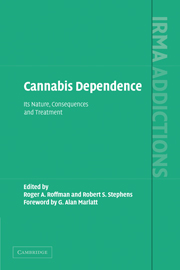Book contents
- Frontmatter
- Contents
- List of Contributors
- Acknowledgments
- Executive Summary
- Foreword
- Part I The Nature of Cannabis Dependence
- Part II Interventions with Cannabis-Dependent Adults
- Part III Interventions with Cannabis-Dependent Adolescents and Young Adults
- 11 The Cannabis Youth Treatment Study: The Treatment Models and Preliminary Findings
- 12 The Teen Cannabis Check-Up: Exploring Strategies for Reaching Young Cannabis Users
- 13 Engaging Young Probation-Referred Marijuana-Abusing Individuals in Treatment
- Part IV Policy
- Part V Conclusion
- Index
11 - The Cannabis Youth Treatment Study: The Treatment Models and Preliminary Findings
from Part III - Interventions with Cannabis-Dependent Adolescents and Young Adults
Published online by Cambridge University Press: 29 October 2009
- Frontmatter
- Contents
- List of Contributors
- Acknowledgments
- Executive Summary
- Foreword
- Part I The Nature of Cannabis Dependence
- Part II Interventions with Cannabis-Dependent Adults
- Part III Interventions with Cannabis-Dependent Adolescents and Young Adults
- 11 The Cannabis Youth Treatment Study: The Treatment Models and Preliminary Findings
- 12 The Teen Cannabis Check-Up: Exploring Strategies for Reaching Young Cannabis Users
- 13 Engaging Young Probation-Referred Marijuana-Abusing Individuals in Treatment
- Part IV Policy
- Part V Conclusion
- Index
Summary
Introduction
Marijuana is the most prevalent psychoactive substance used by adolescents in the US and in many other countries (Office of Applied Studies, 2000; World Health Organization (WHO), 1997). Though the rates of use have leveled off recently, adolescents in the US still report more past month cannabis use than all other illicit substances combined and more daily use of cannabis than alcohol (Monitoring the Future (MTF), 2000). Moreover, while the age of first use has been declining during the past two decades (Bureau of Justice Statistics (BJS), 2000), the potency of cannabis has increased threefold (El Sholy et al., 2000). By 1999, 6.8% of US 18-year-old met criteria for past year cannabis dependence. Cannabis is now the leading illicit substance reported in adolescent arrests, emergency room admissions, autopsies, and treatment admissions (Office of Applied Studies, 2000).
While many adolescents use cannabis without serious problems, it is estimated that half of weekly users develop both behavior and physiological problems (Dennis et al., 2002a). A variety of psychiatric conditions precede or are co-morbid with marijuana abuse and dependence including conduct disorder, attention deficit/hyperactivity disorder, depression, and anxiety (Crowley & Riggs, 1995; Hofler et al., 1999; Robins & McEvoy, 1990). Adolescent cannabis use is also associated with increased problems at school (Fergusson et al., 1996; Newcomb & Bentler, 1988), health problems such as sexually transmitted diseases, and delinquency (National Institute of Justice, 2001).
Keywords
- Type
- Chapter
- Information
- Cannabis DependenceIts Nature, Consequences and Treatment, pp. 247 - 274Publisher: Cambridge University PressPrint publication year: 2006
- 3
- Cited by



